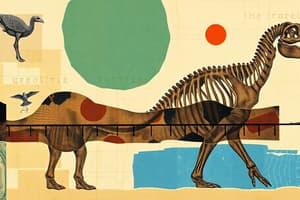Podcast
Questions and Answers
What is the primary purpose of the geological time scale?
What is the primary purpose of the geological time scale?
- To estimate the age of fossils
- To organize the history of the Earth (correct)
- To measure the strength of geological formations
- To evaluate rocks for mining
Which period is characterized as the 'age of reptiles'?
Which period is characterized as the 'age of reptiles'?
- Precambrian
- Cenozoic
- Paleozoic
- Mesozoic (correct)
How long did the Precambrian period last?
How long did the Precambrian period last?
- 4.6 billion years to 541 million years (correct)
- 252 million years to 66 million years
- 541 million years to 252 million years
- 66 million years to the present
During which geological era did the first single-celled organisms appear?
During which geological era did the first single-celled organisms appear?
What major geological event occurred during the Mesozoic era?
What major geological event occurred during the Mesozoic era?
Which of the following is the main reason for limited knowledge about the Precambrian?
Which of the following is the main reason for limited knowledge about the Precambrian?
What marks the beginning of the Cenozoic era?
What marks the beginning of the Cenozoic era?
Which units is the geological time scale divided into?
Which units is the geological time scale divided into?
Flashcards are hidden until you start studying
Study Notes
Geological Time Scale
- An organized timeline of Earth's history
- Divided into time units: Eons, Eras, Periods, Epochs
- Shows major events in Earth's history
- Uses the age of rocks, fossils, and events that formed them
- Rock records and layers reveal changes in conditions over time
The Precambrian
- Extends from 4.6 billion years ago to 541 million years ago
- Little is known about this period due to limited fossil and unaltered rock evidence
- Life first appeared on the planet around 3.9 billion years ago in the form of single-celled organisms
The Paleozoic
- Extends from 541 to 252 million years ago
- Life evolved in the oceans and then colonized land
The Mesozoic
- Extends from 252 to 66 million years ago
- Also known as the "Age of Reptiles"
- Dinosaurs and other reptiles dominated marine and terrestrial ecosystems
- Pangaea, the last of Earth's major supercontinents, formed and broke up, shaping the Earth’s current geography
The Cenozoic
- Extends from 66 million years ago to the present
- Period after the extinction of the dinosaurs
- Emergence of humans in the last 2 million years
Studying That Suits You
Use AI to generate personalized quizzes and flashcards to suit your learning preferences.




